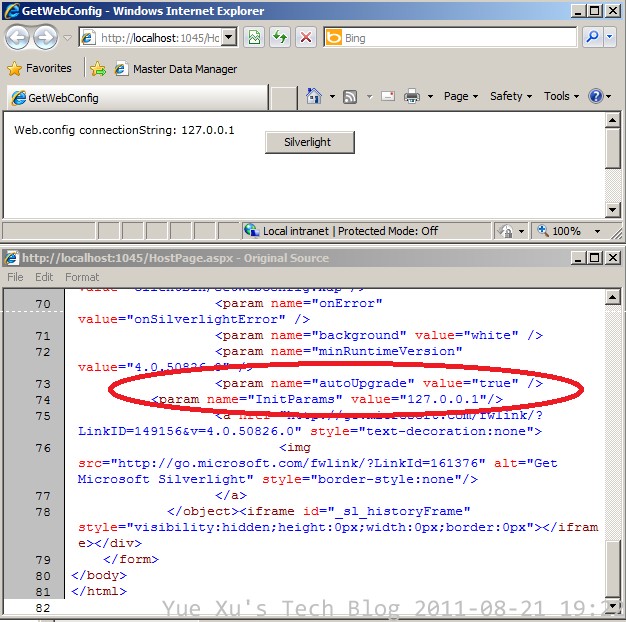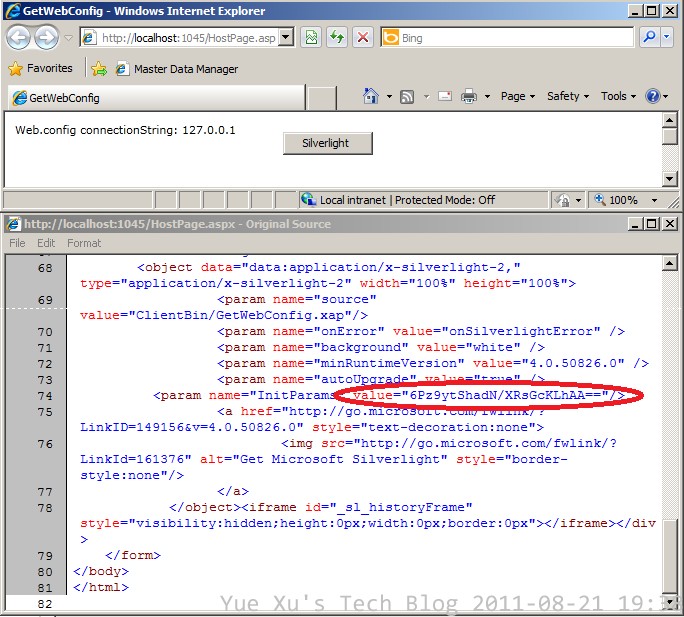在上一篇文章当中,介绍到了通过Silverlight获取web.config中的值,最后提到了加密的问题,因此首先对该安全问题做一个简单的描述。
问题描述
1. 下方是我的web.config文件,当中配置这一个媒体文件服务器的IP地址
<?xml version="1.0"?>
<!--
For more information on how to configure your ASP.NET application, please visit
http://go.microsoft.com/fwlink/?LinkId=169433
-->
<configuration>
<connectionStrings>
<add name="VideoFiles_ConnectionString" connectionString="127.0.0.1"/>
</connectionStrings>
<system.web>
<compilation debug="true" targetFramework="4.0" />
</system.web>
</configuration>
2. 当在Silverlight程序中获取到该config中的值时,我们可以发现,通过查看页面的Source Code,是可以看到这个IP地址的,它是以明文的方式显示出来的,这样会引发安全性问题,我相信没有人愿意将自己的服务器IP地址暴露在外面

解决方法
在Page页面获取到web.config后,对该文件当中的内容进行加密,从而有效地解决了明文显示的问题,这样,别人就不能通过查看源代码的方式从前台获取你的服务器IP地址或者其他机密信息了,其实现方法如下:
1. 在Page页面后台的.cs文件中,加入机密算法,使用Rfc2898DeriveBytes 获取密码、salt 值和迭代次数,然后通过调用 GetBytes 方法生成密钥:
using System;
using System.Collections.Generic;
using System.Linq;
using System.Web;
using System.Web.UI;
using System.Web.UI.WebControls;
using System.Collections.Specialized;
using System.Text;
using System.Configuration;
using System.Security.Cryptography;
using System.IO;
namespace GetWebConfig.Web
{
public partial class HostPage : System.Web.UI.Page
{
protected void Page_Load(object sender, EventArgs e)
{
//Clear the Cache
Response.Cache.SetCacheability(HttpCacheability.NoCache);
WriteInitParams();
}
private void WriteInitParams()
{
string strConn = ConfigurationManager.ConnectionStrings["VideoFiles_ConnectionString"].ToString();
StringBuilder stringBuilder = new StringBuilder();
stringBuilder.Append("<param name=\"InitParams\" value=\"");
stringBuilder.Append(Encrypt(strConn));
stringBuilder.Append("\"/>");
this.litInitParams.Text = stringBuilder.ToString();
}
/**/
/// <summary>
/// 加密数据
/// </summary>
/// <param name="input">加密前的字符串</param>
/// <returns>加密后的字符串</returns>
public static string Encrypt(string input)
{
// salt值
string saltValue = "saltValue";
// 密码值
string pwdValue = "xuyue";
byte[] data = System.Text.UTF8Encoding.UTF8.GetBytes(input);
byte[] salt = System.Text.UTF8Encoding.UTF8.GetBytes(saltValue);
// AesManaged - 高级加密标准(AES) 对称算法的管理类
System.Security.Cryptography.AesManaged aes = new System.Security.Cryptography.AesManaged();
// Rfc2898DeriveBytes - 通过使用基于 HMACSHA1 的伪随机数生成器,实现基于密码的密钥派生功能 (PBKDF2 - 一种基于密码的密钥派生函数)
// 通过 密码 和 salt 派生密钥
System.Security.Cryptography.Rfc2898DeriveBytes rfc = new System.Security.Cryptography.Rfc2898DeriveBytes(pwdValue, salt);
/**/
/*
* AesManaged.BlockSize - 加密操作的块大小(单位:bit)
* AesManaged.LegalBlockSizes - 对称算法支持的块大小(单位:bit)
* AesManaged.KeySize - 对称算法的密钥大小(单位:bit)
* AesManaged.LegalKeySizes - 对称算法支持的密钥大小(单位:bit)
* AesManaged.Key - 对称算法的密钥
* AesManaged.IV - 对称算法的密钥大小
* Rfc2898DeriveBytes.GetBytes(int 需要生成的伪随机密钥字节数) - 生成密钥
*/
aes.BlockSize = aes.LegalBlockSizes[0].MaxSize;
aes.KeySize = aes.LegalKeySizes[0].MaxSize;
aes.Key = rfc.GetBytes(aes.KeySize / 8);
aes.IV = rfc.GetBytes(aes.BlockSize / 8);
// 用当前的 Key 属性和初始化向量 IV 创建对称加密器对象
System.Security.Cryptography.ICryptoTransform encryptTransform = aes.CreateEncryptor();
// 加密后的输出流
System.IO.MemoryStream encryptStream = new System.IO.MemoryStream();
// 将加密后的目标流(encryptStream)与加密转换(encryptTransform)相连接
System.Security.Cryptography.CryptoStream encryptor = new System.Security.Cryptography.CryptoStream
(encryptStream, encryptTransform, System.Security.Cryptography.CryptoStreamMode.Write);
// 将一个字节序列写入当前 CryptoStream (完成加密的过程)
encryptor.Write(data, 0, data.Length);
encryptor.Close();
// 将加密后所得到的流转换成字节数组,再用Base64编码将其转换为字符串
string encryptedString = Convert.ToBase64String(encryptStream.ToArray());
return encryptedString;
}
}
}
2. 之后,在Silverlight页面获取config数据的时候,通过解密算法进行解密,得到真正的IP地址信息:
using System;
using System.Collections.Generic;
using System.Linq;
using System.Net;
using System.Windows;
using System.Windows.Controls;
using System.Windows.Documents;
using System.Windows.Input;
using System.Windows.Media;
using System.Windows.Media.Animation;
using System.Windows.Shapes;
using System.Security.Cryptography;
using System.IO;
using System.Text;
namespace GetWebConfig
{
public partial class MainPage : UserControl
{
private IDictionary<string, string> _config;
public MainPage()
{
InitializeComponent();
_config = (Application.Current as App).Configurations;
if (_config.Count > 0)
lblWebconfig.Content = "Web.config connectionString: " + Decrypt(_config.ElementAt(0).Key.ToString() + "==");
}
/// <summary>
/// 解密数据
/// </summary>
/// <param name="input">加密后的字符串</param>
/// <returns>加密前的字符串</returns>
public string Decrypt(string input)
{
// salt值(与加密时设置的值一致)
string saltValue = "saltValue";
// 密码值(与加密时设置的值一致)
string pwdValue = "xuyue";
byte[] encryptBytes = Convert.FromBase64String(input);
byte[] salt = Encoding.UTF8.GetBytes(saltValue);
System.Security.Cryptography.AesManaged aes = new System.Security.Cryptography.AesManaged();
System.Security.Cryptography.Rfc2898DeriveBytes rfc = new System.Security.Cryptography.Rfc2898DeriveBytes(pwdValue, salt);
aes.BlockSize = aes.LegalBlockSizes[0].MaxSize;
aes.KeySize = aes.LegalKeySizes[0].MaxSize;
aes.Key = rfc.GetBytes(aes.KeySize / 8);
aes.IV = rfc.GetBytes(aes.BlockSize / 8);
// 用当前的 Key 属性和初始化向量 IV 创建对称解密器对象
System.Security.Cryptography.ICryptoTransform decryptTransform = aes.CreateDecryptor();
// 解密后的输出流
MemoryStream decryptStream = new MemoryStream();
// 将解密后的目标流(decryptStream)与解密转换(decryptTransform)相连接
System.Security.Cryptography.CryptoStream decryptor = new System.Security.Cryptography.CryptoStream(
decryptStream, decryptTransform, System.Security.Cryptography.CryptoStreamMode.Write);
// 将一个字节序列写入当前 CryptoStream (完成解密的过程)
decryptor.Write(encryptBytes, 0, encryptBytes.Length);
decryptor.Close();
// 将解密后所得到的流转换为字符串
byte[] decryptBytes = decryptStream.ToArray();
string decryptedString = UTF8Encoding.UTF8.GetString(decryptBytes, 0, decryptBytes.Length);
return decryptedString;
}
}
}
最终实现效果如下,这时候我们通过查看源文件看到的则是被加密后的信息,而不是127.0.0.1,只有在Silverlight进行解密之后,才能看到我们想要的数据。
